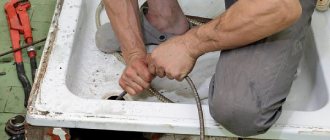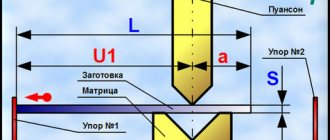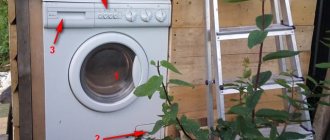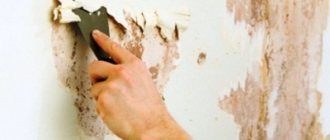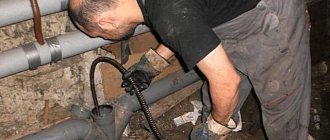Due to its high efficiency and low fuel consumption, gas equipment has become widespread among the population. But for all its advantages, unfortunately, blue fuel can actually be dangerous if used incorrectly. Explosions, fires, poisoning and suffocation - these are the dangers that a 5 percent concentration of household gas in the air can cause.
In this article we will tell you what methods you can use to check for gas leaks at home, and how to avoid a tragedy.
Main causes and locations of gas leaks
Sometimes a normal household leak is enough to cause a powerful explosion. An explosive mixture is formed when the concentration of blue fuel in the air reaches 5-15%. Under such circumstances, even turning on the light in the room will serve as a “trigger”.
Two types of gas are used in everyday life: natural , which is centrally supplied through a main pipeline, and liquefied , stored in special cylinders. Often, troubles are associated with gas cylinders. They explode when dropped or improperly stored or used.
When methane enters the surrounding air, it reduces the amount of available oxygen. As a result, people in a gas-filled room experience oxygen starvation, which leads to suffocation.
In addition to elementary negligence and ignoring the rules for operating devices, common causes of leakage include the following:
- re-equipment, unauthorized installation of gas boilers and stoves in the wrong place, without prior agreement with specialists;
- illegal connection of devices by private individuals who do not have permission for such work;
- wear of gas pipes;
- poorly performed welding, rupture of welded joints;
- corrosion damage to the walls of the gas pipeline;
- ruptures and damage to hoses connecting equipment to the main line;
- abrasion of sealing materials on taps and hoses, poor quality of threaded connections;
- loose closing of the gas valve;
- extinguished flame when the burner is on (due to a draft, spilled water, contamination of the structure);
- Incorrect burner operation.
One of the most commonplace household reasons is incomplete closing of the gas burner.
Typically, leakage occurs in places of pinpoint deformation of pipes and valves outside and inside the house, in the area of rupture of gas stove hoses, leaking threaded and flange connections. This is caused by wear and tear of materials.
What is the danger of operating a gas stove with the window closed?
- The main problem: the gas does not burn completely, which causes toxic substances to be released into the air. In particular, this is carbon monoxide, the concentration of which exceeds the permissible values. This provokes various ailments: migraines, weakened immunity, allergies, etc.
- When operating the stove indoors, the situation is aggravated if the room itself is small and poorly ventilated. The work of a housewife who regularly cooks in such conditions can be considered hazardous work. This is due to the fact that with low ceilings, all substances released during combustion accumulate in the upper layers of air. Therefore, ventilation of the room when cooking is extremely important, even if it is at least an open window.
Physical symptoms
A decrease in the amount of oxygen in the air causes symptoms of a gas leak. These may include:
- labored breathing
- dizziness
- tiredness or drowsiness
- feeling dizzy
- flu symptoms
- headache
- eye and throat irritation
- mood changes, including depression
- nausea
- chest pain
- pale skin or blistering after direct contact with gas
- loss of appetite
- tinnitus
Pets are also likely to experience symptoms if there is a gas leak. Pet owners should look out for signs of:
- labored breathing
- changes in mood or behavior
- disorientation
- lethargy
- loss of appetite
- sore throat
- red or watery eyes
- vomit. Very high levels of gas can cause unconsciousness or even death in pets.
Carbon monoxide poisoning
Symptoms of carbon monoxide poisoning may include headache and fatigue.
Symptoms of carbon monoxide poisoning may include headache and fatigue.
Carbon monoxide (CO) poisoning can result in symptoms similar to those caused by a gas leak. Carbon monoxide is released when gas is incompletely burned.
Exposure to CO can be fatal and is a medical emergency.
Symptoms of carbon monoxide poisoning may include:
- abdominal pain
- chest pain
- dizziness
- fatigue
- headache
- loss of muscle control
- nausea
- pink skin and bright red lips
Causes of gas leaks
The causes of gas leaks in your home or apartment are most often simple negligence and ignorance of operating rules. The main reasons are as follows:
- Illegal installation of appliances: stoves and gas boilers.
- Self-connection or connection by private individuals who do not have permission to carry out this type of work.
- The owner of a private home does not have a service agreement.
- Careless handling of gas equipment: failure to check the tightness of connections, ignoring cleanliness rules.
- Failure to follow the procedure for turning on and off equipment.
- Ignoring the timing of inspections by the residents themselves or the management organization: gas boilers are subject to inspection once a year, stoves - once every three years.
The cause of a gas leak may be improper installation.
Residents of apartment buildings, through a management company, enter into an agreement for the maintenance of gas facilities, which guarantees periodic inspections and elimination of accidents.
The presence of a maintenance contract does not eliminate the need for residents to comply with preventive measures.
The control unit of the stove and the automatic ignition unit have failed
If everything is in order with the electrode spark plug and wire, the fault lies in the unit itself. One of the channels is probably damaged. A breakdown of the electric ignition unit is indicated by a too weak, intermittent yellowish spark or a complete absence of a spark on all electrodes. You can check this fault yourself by turning on the ignition in the dark.
If the spark, as I said, is orange-yellow, then the block is 99% worn out. The unit is located inside the slab and repairs require disassembly. It is unlikely that you will be able to resolve this issue on your own. After replacement the spark will be correct, bright blue
Please note that the unit cannot be repaired; it must always be replaced
How to check for gas leaks in an apartment/house
The smell of gas is familiar to everyone; it is difficult to confuse it with other odors. If you smell gas:
- Try to reduce breathing (if there is a high concentration of gas in the lungs, loss of consciousness is possible).
- Open all windows.
- Do not turn on electrical appliances. Do not use fire (matches, lighters).
- Close the main valve on the gas pipe.
- Call the gas service at number 04, from a cell phone 104. You can also dial 112.
But in most cases, people ignore these simple rules. Begin an independent leak search. They use traditional methods of searching for gas leaks: soap solution, lit match.
Remember: gas, followed by fire, does not forgive mistakes. If you smell the smell, call 112, or immediately call the gas service 04, 104.
An adult who is awake can react to the smell. What to do when there are children, elderly people at home or at night when most people are sleeping and the smell of gas is difficult to smell? Gas leaks during such events in most cases lead to tragedy.
When a room is filled with gas, deaths from gas poisoning are common. When everyone in the apartment went to bed and didn’t wake up. Alas, such news is not often advertised, but there are many such cases.
Therefore, you should not rely on equipment inspections by gas services, or on your sense of smell and instinct. This is where the question arises - how to protect yourself from explosions and suffocation from household gas. Special sensors are produced to detect gas in residential premises.
Requirements for a stove with electric ignition
A stove with electric ignition must be connected to the network.
And for this you need a grounded outlet. If it is not nearby, separate wiring is done. In this case, the wire must be three-core and with a cross-section of at least 1.5 mm in diameter. In parallel, the electrical panel must be equipped with a 16A protection element. It can be an RCD or differential, or a regular machine. As for the cord itself, it is usually included with gas stoves with electric ignition by default. If it is missing, it is made independently, using a three-core wire of suitable cross-section and a plug with grounding contacts. But you can buy it. There are two main options for installing a differential machine. It is installed alone for the entire electrical network, or several products are installed, one for each individual line. It is possible to install a differential circuit breaker during selective installation not on every line, but only where it is necessary to ensure the safety of people in the event of possible contact with live parts of electrical equipment. In this case, you need to be guided by the main rule for installing difavtomats - this should only be done by a specialist.
Instructions
Check the installed device for damage and cracks in accordance with the requirements of the Installation Rules. This must be done, since in the presence of these malfunctions, full protection will not be provided. These rules apply to all such devices without exception. You should carefully check the proper operation of the device’s activation mechanism and the corresponding markings on the product body. Differential circuit breakers and RCDs (residual current devices) are almost identical products, so they are connected in the same way.
Install the differential circuit breaker in the electrical panel on a DIN rail. The principle of its operation: it compares the electric current passing through the phase conductor with the current passing through the neutral conductor. Their value is usually the same if the device is in working order and the insulation of the electrical wiring is not damaged. If a leakage current occurs in the circuit, their value will become different. The difavtomat will instantly detect these changes and compare the level of leakage current with the rated value provided for this device. When the leakage current readings exceed the rated value, the machine will turn off the power to this section of the electrical network. It is possible to turn on the power supply again only after troubleshooting.
Connect two wires to the differential machine - neutral and phase for a 220 V network, or three phase and one neutral for a 380 V network. A differential machine differs from an RCD in that it not only protects a person from electric shock, but also automatically disconnects any section of the network in in case of overload or short circuit. It has built-in overcurrent protection, which is not present in the RCD. According to regulatory regulations, it is recommended to install only differential circuit breakers. It is strictly forbidden to install ordinary RCDs in group lines, unless there is an additional device responsible for protection against short circuits and overloads. There are separate regulations for installing these devices in residential premises. Only type “A” residual current devices that respond to pulsating and alternating fault currents are allowed for installation. You can also install RCDs of the “AC” type, which respond only to alternating leakage currents.
Video on the topic
On many models of gas stoves, designers install automatic ignition, which is turned on with the gas supply or from a separate button. This function is very convenient: you do not need to come into contact with an open flame in order to light the burner. If you suddenly discover that the automatic ignition on a gas stove does not work, do not rush to call the service: it is quite possible to repair this malfunction yourself.
How to check for leaks in an apartment or house?
Identification and timely elimination of leaks is the main condition for the safe operation of gas appliances. Having noticed any signs indicating a problem, it is advisable to immediately call the gas service.
There are several checking methods that will help you understand whether there is a gas leak and whether you should sound the alarm.
Method #1 - by smell and hearing
The main sign indicating a probable leak is a characteristic specific smell in the room.
The odorant for blue fuel is ethyl mercaptan, a toxic substance with a rich, specific odor. It is added to the mixture in a small, safe amount, which is enough for the aroma to be clearly felt in the air.
The gas itself, intended for domestic use, is neutral, both in color and odor. But to prevent emergency situations, special substances are added to it - odorants. It is these components that give the mixture an unpleasant aroma, which makes it possible to accurately determine the excess gas concentration in the air.
If there is a strong smell of rotten cabbage, rotten eggs or rotten hay in the room, then there is a leak somewhere. It is often mistaken for the stench of spoiled food, the aromas of fuels, lubricants and paints. However, if you suspect something is wrong, you should definitely make sure that there is no problem.
If you notice the characteristic smell of gas in the room, you need to contact a gas specialist or use additional testing methods. The emergency service responds to such messages quite quickly and arrives on site within 40 minutes on average.
Another sign of leaks is a whistling sound that appears in places of depressurization. In damaged areas, gas escapes in a strong stream with whistling and hissing. This sound indicates obvious, serious malfunctions.
Method #2 - checking for leaks by touch
Even though the gas is invisible, its leak can be felt by touch. To do this, you should run your hand along the junctions, joints, and flange connections of the gas pipeline. The mixture coming out feels like a stream of cold air.
Because methane is cooler than air, it cools the skin slightly when performing a tactile test. To increase sensitivity, it is better to perform manipulation with wet hands
The tactile method is only suitable for easily accessible places where gas pipes are not covered by a kitchen unit. In restricted areas, other inspection methods are used.
Method #3 - testing with soap solution
To confirm the presence of a malfunction and identify the problem area, conduct a visual inspection of the pipes using a soap solution to check for gas leaks.
A specially prepared foam solution is applied with a thick brush or shaving brush to hoses, pipes, and joints. It is recommended to lubricate valves and connecting elements especially carefully.
After application, it is important to carefully inspect each area coated with the solution. If soap bubbles appear somewhere, this indicates the release of gas in this area.
To prepare a “diagnostic” solution, any shampoo, shaving foam, soap, or washing powder is suitable. You need to dilute the product in water and beat it into foam.
When checking the external gas pipeline outside the house, you need to pay attention to brown spots on the snow, yellowing of vegetation, disturbances in the ground cover and the formation of snow frost. These are all signs of a possible leak.
Method #4 - pressure testing for residual pressure
Next, we’ll look at how gas leaks in hard-to-reach places in an apartment are determined. The method of pressure testing for residual pressure is ideal if it is inconvenient to make your way with a soap solution and instruments. It allows you to check all connections: from the burners to the tap. The manipulation will take several minutes to complete.
First you need to open the burners and pass gas through them. Then you should turn them off and close the gas valve on the pipe. Thus, a residue that has not completely burned out will appear in the system.
Next, after waiting from 1 to 3 minutes, perform the following steps:
- remove the lid from any burner;
- a lit match is brought to the middle;
- The burner switch is sharply opened to the maximum position.
If there are no leaks, the remaining gas in the system will burn out. Otherwise, the residue will have time to escape through the damaged area and nothing will happen when the fire is brought to the burner.
Method #5 - using sensors and a gas analyzer
The safest, most reliable and practical way to detect a leak is to install a gas detector in the room. This is a special device equipped with sensors that detect the presence of methane and carbon monoxide in the air.
If the concentration of these substances is exceeded, light and sound signals are activated, notifying the owner of the problem. The device is installed at a distance of at least 30 centimeters from the ceiling.
There are different types of sensors, differing in design, connection method, degree of autonomy, and operating principles. Their range is represented by simple models and multifunctional devices that work with several types of substances (flammable mixtures, carbon monoxide)
Wired sensors operate on mains power, while wireless sensors operate on batteries. The former are easier to maintain and do not require monitoring the battery charge level. The latter are mobile and do not depend on electrical power.
The main difference between the models is the method of determining fuel concentration, according to which there are three types of gas analyzers:
- catalytic;
- semiconductor;
- infrared.
Catalytic gas analyzers are more often used at industrial facilities; they can operate either from the mains or from batteries. They are equipped with a chamber in which a small amount of gas burns, triggered even when its concentration is slightly exceeded. At the same time, the temperature of the coil changes, to which the electronic microcircuit responds by triggering notifications.
Semiconductor sensors are affordable and designed for home use. They operate only from the network, while their energy consumption is minimal.
The devices are equipped with a plate of semiconductor material coated with a certain chemical composition. If gas enters the plate, its electrical resistance changes. This is recorded by an electronic circuit that turns on the alarm
Infrared models are the most reliable and convenient. They operate on batteries and mains power. Their advantages include instant response, a minimum of false alarms, and economical energy consumption.
Infrared sensors analyze the air using radiation, easily detecting the presence of gas particles due to differences in light scattering. When contamination is detected, a light and sound alert is activated
In addition to stationary equipment that continuously analyzes the gas environment, there are portable gas analyzers that are used to locate leaks in pipes or briefly measure gas concentrations. They are usually used by gas service specialists.
The stove is powered by a gas main
Considering the numerous myths about gas stoves, we can highlight the following common facts:
Danger. Often it is gas stoves that cause an explosion in an apartment building in the event of a gas leak. But as it turns out in practice - upon detailed investigation - it becomes clear that the danger lies in the improper operation of the stove by its owners themselves. Modern models are equipped with a safety system - if the fire goes out, the gas supply is interrupted after a few seconds. As a result, a small amount of gas accumulates in the room - the volume will not lead to an explosion even due to a lit match.
Appearance of a burner that requires repair
- Inconvenient to use. This is evidenced by housewives who are forced to constantly monitor the temperature in the oven and the supply of fire under the pan to ensure even cooking. This factor has a second side - most housewives like it. In their opinion, independent regulation of the gas supply makes it possible to obtain both crispy crusts on baked goods and crispy meat. With electric varieties, the presented actions are difficult to carry out.
- The released gas burns oxygen in the room and releases decomposition products that are harmful to breathing. The combustion of oxygen during cooking is extremely small, especially if the room intended for the kitchen has a large area.
To understand the cause of soot, you need to know how a gas stove works. The design of any modern stove, in addition to the oven, includes such an important element as a burner, thanks to which gas is used safely for cooking. It consists of several parts.
- The first thing you notice is the divider. It is presented as a gear flange bushing. The space between the teeth distributes the gas in a circle, creating an even flame.
- The design is complemented by a divider cover located in the upper part of the burner. Most often they are made of durable stainless steel, but the material can be any.
Having disassembled the burner to the base, you can see a small bolt with a through hole in the middle. This part is called a jet. Its diameter does not exceed one millimeter, and it is through it that the gas enters the divider. Most often, the part is made of brass or a material with similar properties. If the bolt hole is too large, the burner will start to smoke.
Replacing the jet if you have a replacement kit is quite easy - any home craftsman can do it.
Procedure for detecting a leak
If you suspect a leak, you should not fix the possible damage yourself. Instead, you need to immediately call the emergency gas service by calling “104” or call the single emergency number “112”. Moreover, it is better to do this after leaving the apartment.
You cannot use mobile and landline phones in a gas-filled room..
Before the arrival of specialists, it is important to adhere to certain rules of conduct.
First of all you need to:
- Stop the gas supply as quickly as possible by closing the gas pipe valve located behind the stove and the dispenser tap.
- Open all windows, vents and the entrance door in the room, ensure through ventilation.
- Remove people and leave the premises to the street or to a safe place.
- Turn off the electricity supply to the panel.
Under no circumstances should you turn lights or electrical appliances on and off. Any small spark can become the detonator of an explosion.
If you suspect a gas leak or fire, you must call emergency services and be sure to warn your neighbors. You should not try to solve the problem on your own: you must wait for the specialists to arrive and then act according to their instructions
If gas ignites in a damaged area, do not extinguish the flame yourself. As long as the mixture burns, it will not explode. In this case, you should immediately leave the premises and call the rescue service.
Size
The slabs come in different sizes. I’ll say right away that cooking simultaneously on four burners on a stove 50–60 cm wide is inconvenient (although possible). If you constantly cook on several burners at once, and space allows, then it is better to choose a larger stove (70 cm or more).
Pay attention to the location of the burners. Will it be convenient for you to use the stove when there are large and small burners in front, and two main workers (medium sizes) in the background? I was lucky enough to buy just such a stove. It is not difficult to rearrange the burners, but this is a separate task for a gas technician, although I did it myself. About this at the link.
What to do after a gas leak
A gas leak is usually confirmed by a certified inspector using a device called a tuned electronic gas analyzer. The inspector will also check appliances and external gas lines for faults and leaks.
After detecting and repairing a leak, you must:
- wait for official notification that it is safe to return home
- ventilate the house before returning inside
- install carbon monoxide alarm
Symptoms of a gas leak usually do not affect health if the exposure was low and the leak was repaired quickly. However, long-term exposure may result in lingering physical symptoms such as:
- depression
- other mood problems
- breathing problems
Therefore, it is important to consult a doctor after a gas leak, especially if a person notices long-term effects. Symptoms may improve or resolve with proper treatment.
Cost of services and penalties
Prices for inspection services vary depending on the type and capacity of the installed equipment and are:
- if you only have a gas stove - from 500 rubles;
- when installing a geyser or boiler - from 1000 rubles.
However, for evading an event, a citizen is brought to administrative responsibility (Article 9.23 of the Code of Administrative Offenses (CAO RF)), and if they cause harm to someone else’s property or health, they risk being brought to criminal liability.
The amounts of penalties are presented in the table:
| Violator status | Amount of fine (thousand rubles) | |
| For failure to fulfill a duty | For causing an accident or a threat to health and life | |
| Individual – citizen | 1 — 2 | 10 — 30 |
| Responsible official | 5 — 20 | 50 — 100 |
| Entity | 40 — 100 | 100 — 400 |
Refusal to sign a maintenance contract or blocking access for specialists to inspect equipment can lead to interruption of gas supply and harm to neighbors.
Set of preventive measures
A number of preventive measures will help prevent gas leaks, associated extreme situations and other unwanted problems.
Rules mandatory for all household consumers:
- when leaving the house, turn off all gas appliances, close the valves responsible for the gas supply;
- do not connect or repair the equipment yourself or with the involvement of dubious specialists, and you cannot make any changes to the design;
- monitor the proper functioning of the supply and exhaust ventilation, request a draft check from gas company specialists, regularly ventilate the premises;
- do not use the stove for heating, drying things and other items made of flammable materials;
- remember the correct sequence of turning on the appliances: first light a match, and only then open the gas;
- do not leave the switched on equipment unattended, do not allow children and persons unfamiliar with the operating rules to access it;
- When checking for leaks, do not use lit matches or a lighter.
As for gas cylinders, they need to be refilled exclusively at specialized points. Containers should be stored in well-ventilated areas, but not on balconies, apartments or garages. They should be in an upright position in the shade, since heating from the sun's rays is contraindicated for them.
Possible problems can also be judged by the color of the flame in the burners. It should be calm and have a deep blue color. Red, green and orange shades on fire are a reason to contact the gas workers
The most important rule is not to neglect the standards prescribed in the instructions for the safe operation of devices .
Gas equipment installed in the house must be in good condition, meet technical requirements, and undergo regular maintenance and inspection. The use of faulty devices is strictly prohibited.
Self-modification of the nozzle
If you determine that the equipment has unsuitable nozzles and there are no replacements, then you can find many recommendations for modifications on the Internet. They explain in detail how this can be done using a soldering iron, solder, sandpaper and sewing needles. It is recommended to check the performance of the resulting product experimentally.
But please note, this is very dangerous! The result of such an experiment may be a leak. You should not expose your life and health to such danger. Better to buy a new part
Better to buy a new part
You should not expose your life and health to such danger. It's better to buy a new part.
prevention
Arrange for a professional to regularly inspect gas combustion appliances and piping.
Arrange for a professional to regularly inspect gas combustion appliances and piping.
Most gas leaks can be prevented by doing the following:
People should learn about the symptoms and signs of gas leaks and remember to teach family members and children about natural gas safety.
Everyone in the home should know what to do if a gas leak is suspected or confirmed.
Regular inspection schedule
Ensure that all gas combustion appliances and gas lines are inspected annually by a certified inspector.
A certified technician should also inspect furnaces, chimneys, chimneys, and vents.
Ensure adequate ventilation
The areas around gas burning appliances and gas equipment must be kept clear. This is necessary to prevent the accumulation of natural gas in these areas.
It is also useful to regularly ventilate the house.
Install carbon monoxide detectors
These devices look like smoke alarms and make a loud sound when they detect carbon monoxide. There should be a detector on every floor of the house and in all bedrooms.
Keep the fire extinguisher in place
Gas leaks are highly flammable, and natural gas can be ignited by a spark or even telephone calls. Respond quickly to house fires by having at least one multi-purpose fire extinguisher on site.
Chemical storage
All flammable materials and household chemicals, such as detergents and paints, should be stored away from gas appliances and gas lines.
Natural gas leaks cause physical signs and symptoms in both humans and animals. Although these leaks are rare, continued exposure to natural gas can be dangerous and have long-lasting consequences.
It is important that people are educated about the safety of natural gas and aware of the signs of gas leaks and carbon monoxide poisoning.
There are many steps you can take to prevent gas leaks and their complications, including scheduling annual inspections and installing carbon monoxide detectors.
Independent work
What to do if the gas cylinder is leaking gas? The following manipulations will be required (only suitable for VK-94 models).
Take a 2.7 cm wrench. Tighten the nut (marked in the image). The motion vector is clockwise (CW).
When the flywheel opens and the valve of the propane tank is released, unscrew the flywheel in the opposite direction to the very limit.
If these options do not produce an effect, then you must:
- Unscrew the nut located under the flywheel. The movement is against the emergency. It is then removed from the tank.
- Using a wrench, unscrew the nut at the top of the flywheel by 1 cm.
- The rod is removed from it. There is a sealing gasket there.
It should have two holes:
- internal - maximum 8.5 mm.
- external – identical to the internal parameter of the nut (diameter).
After installing a new product, the rod should be placed very tightly. He will need to be hammered. You can do this with a hammer or the flat side of a key. After which the flywheel returns to its position and is screwed with a nut. It should not be screwed all the way. There is no need to clamp the spring here. It should be taut. Otherwise, the flywheel will not rotate.
Such measures often become a solution to a dilemma - what to do if a gas cylinder leaks? It is important at the end of the operation to put the assembly back on the cylinder and screw it with a nut. Vector - according to emergencies
You need a 2.7 cm key. Force: 5-7 kg. Don't screw it all the way.
If you have a VKB faucet, you cannot disassemble it yourself. If there is still gas in the container and even a small percentage of residual pressure, opening the nut is life-threatening! After all, only it holds back the pressure in this unit. It can only be repaired in a devastated state.
There is a small hole at the back of this valve. If the diaphragms are breached, gas escapes.
The VKB modification is usually mounted on a helium tank. For other gases use VK-94.
Beware, scammers!
In the wake of general panic after the explosions, scammers begin to walk around apartments, offering to either buy that same analyzer, or urgently check the pipes - as they say, without SMS or registration. Such “traveling salesmen” should be (im)politely kicked out: the functionality of the devices they sell is close to a laser pointer, and the price exceeds all reasonable limits. By the way, it is worth warning your elderly relatives about such visits.
Checks can only be carried out by special service employees. They have to:
- notify in advance of the inspection;
- provide documents upon your request;
- be dressed in appropriate uniform.
If you have any doubts about who actually came for the inspection, don’t be lazy and find the organization’s phone number on the Internet and find out.
Table grates
Grates are installed above the gas burners. Firstly
, they may be crooked from the very beginning. Secondly
, they may become deformed when heated. I advise you to check for deformation when purchasing. To do this, you need to place a frying pan on the stove. The pan should stand on four points, and not swing on three or two. Regarding deformation from heating. Check with the seller whether the manufacturer's warranty covers this deformation, read reviews on the Internet about the slab you have chosen regarding the deformation of the gratings.
Only cast iron grates are guaranteed against deformation, but they are now very rare. But it has become fashionable to paint light alloys like cast iron. It is very easy to distinguish cast iron. Cast iron is not painted, as it is very technologically difficult and pointless. Cast iron is black or dark dark gray (almost black) in color and is very heavy. Products painted to look like cast iron have a lighter color or colored shades, they are much lighter.
